Major
Major triads on GBE
On the top three strings of the guitar, the three close voicings of the C Major triad are played as follows:

Fig 1. C Major all inversions on GBE
Notice that when moving up the neck to the next inversion, each “voice” in the triad (lowest, middle, or highest pitch) moves up to the next higher note.
When moving from the root inversion to the 1st inversion, the C (root) on the 3rd string moves to E (M3), E moves to G (p5), and G moves to C (root). CEG → EGC.
The same thing occurs going from first to second inversion: EGC → GCE. And again when repeating the next higher root inversion (at frets 15-17 if you can reach): GCE → CEG.
These three shapes allow you to play any major chord! If you move any of these three shapes two frets higher, it forms D Major (the notes D, F♯, and A).
It’s very important to remember where the root note is in each of these shapes!
You’ll often find yourself thinking only about the root notes of each new chord in a song or progression. You’ll then find the closest location for that note and form the rest of the shape around it.
If you want to play G major, for example, you can choose between the G at the 12th fret 3rd string, 8th fret of the B string, or 3rd fret of the E string. It’s then just a matter of forming the correct shape around that root note. It gets easier with practice!
RT4a1 • Major: GBE
Now spend a practice session or two attempting this proficiency test.Major triads on all string sets
Triads exist on more than just the top three strings, of course. Let’s figure out the remaining shapes.
An excellent way to learn these additional shapes is using what Josh at Fretboard Anatomy calls “Octave Drop Chord Building.” Basically, we use familiar octave shapes to drop the highest pitched note in a triad shape we already know one octave (and three strings) lower.
Starting with the root inversion C Major triad we already know:
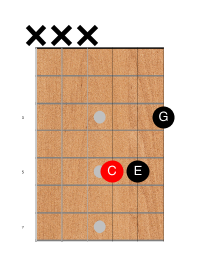
Fig 2. C Major, GBE, root inversion
We drop the G on the highest string one octave and play it on the D string like this:
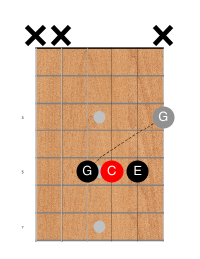
Fig 3. C Major, DGB, 2nd inversion
Since the fifth is now in the base, this is a 2nd inversion. You may recognize the shape from an open A chord (with that shape three frets lower down the neck).
We use the same process to move to the A, D, and G strings:
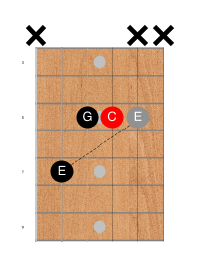
Fig 4. C Major, ADG, 1st inversion
Then we find the root inversion in the same way on the low-E, A, and D strings:
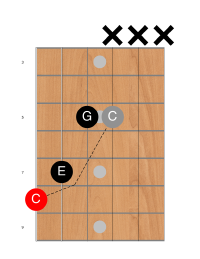
Fig 5. C Major, EAD, root inversion
We can (and will!) use the exact same “octave drop” technique for every inversion and every triad type (major, minor, diminished, or augmented).
Indeed, you can use this trick with any chord, melody, or scale fragment!
Before we explore the minor, diminished, and augmented triad types, however, let’s complete the octave drop technique with the remaining two inversions of a major triad.
The root position dropped all the way down to the note C at the 8th fret of the low E string. The 1st inversion of C Major on the top strings is also at the 8th fret. So move the C over onto the same fret of the high E and start dropping the 1st inversion shape down the strings:
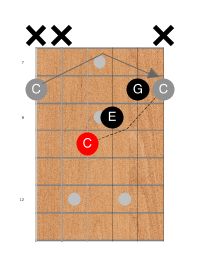
Fig 6. C Major, DGB, root inversion
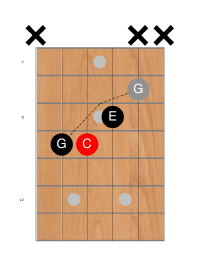
c-major-ADG-2nd.png
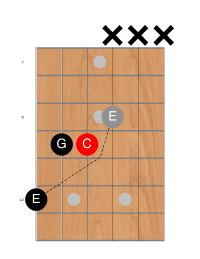
c-major-EAD-1st.png
Now that we’ve “run out of strings” by dropping the 1st inversion, let’s continue with the last inversion of C major. First, move the E we dropped to the 6th string over to the same fret on the high E string, and then start dropping the 2nd inversion shape:
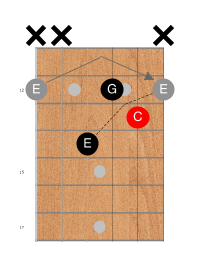
Fig 7. C Major, DGB, 1st inversion
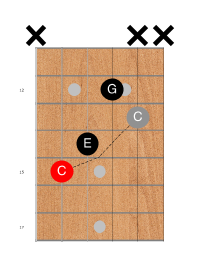
Fig 8. C Major, ADG, root inversion
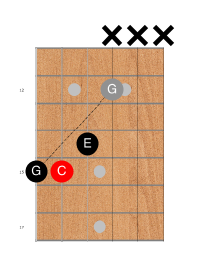
Fig 9. C Major, EAD, 2nd inversion
Other string sets
Let’s summarize the shapes we’ve discovered using this octave drop technique.
Figure 1 showed the inversions on the top string set.
Here are the shapes for each inversion on the DGB string set:

Fig 10. C Major inversions on DGB
RT4a2 • Major: DGB
The proficiency test for triads on DGB.The top four strings are by far the most important for soloing and comping in a band situation. I strongly suggest you practice the inversions on the GBE and DGB string sets first. You should learn the shapes on all string sets eventually, but the top four strings will take you a long, long way (head and shoulders above countless other guitarists).
Here are the shapes on the remaining string sets:

Fig 11. C Major inversions on ADG
RT4a3 • Major: ADG
The proficiency test for triads on ADG.
Fig 12. C Major inversions on EAD
RT4a4 • Major: EAD
The proficiency test for triads on DGB.Note that I’ve moved the 2nd inversion in that last diagram down to a lower position on the neck.
Minimal movement drills
All of the proficiency tests we’ve done so far have you stay on the same chord throughout, and requires you to move your hand several frets to find each new inversion.
This next drill has you progress through the entire cycle on the same string set and only requires you to move your hand slightly.
This test restricts us to the top four strings (the most important strings for soloing and finding notes).